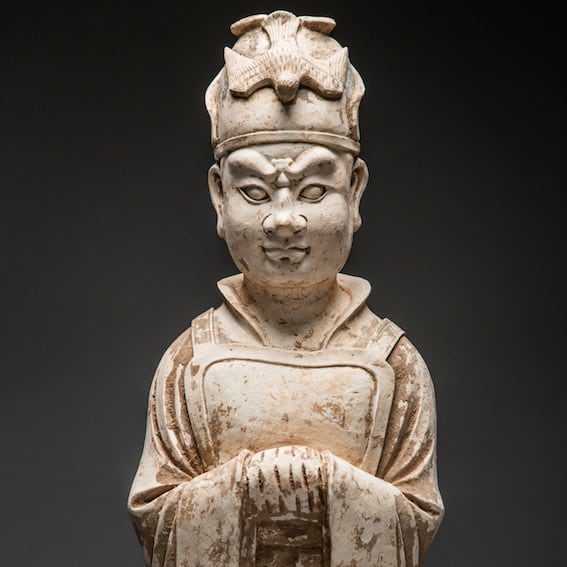Tang Painted Terracotta Sculpture of a Civic Official, 618 CE - 906 CE
Painted Terracotta
height 96.5 cm
height 38 in
height 38 in
H.716
Further images
The T’ang Dynasty was an era of unrivalled wealth and luxury. The country was successfully reunified and the borders were expanded, pushing Chinese influence into new lands. Confucianism became a...
The T’ang Dynasty was an era of unrivalled wealth and luxury. The country was successfully reunified and the borders were expanded, pushing Chinese influence into new lands. Confucianism became a semi-religious instrument of the state; yet Buddhism continued to flourish, spreading into Korea and Japan. The arts reached new levels of sophistication. Poetry and literature flourished under the enlightened rulers. The Silk Road brought fortunes into China. Precious treasures were imported on the backs of camels from far away lands and bartered for Chinese silk, medicinal herbs, and pungent spices. T’ang China was a multicultural empire where foreign merchants from across Central Asia and the Middle East settled in the urban centers, foremost among them the thriving capital of Chang’an (modern X’ian), a bustling cosmopolitan center of over two million inhabitants. Foreign traders lived next to native artisans and both thrived. New ideas and exotic artistic forms followed alongside. The T’ang Dynasty was a cultural renaissance where many of the forms and objects we now associate with China were first created. Moreover, this period represents one of the greatest cultural outpourings in human history.
This general type of Chinese burial art is known as mingqi. Mingqi were any of a variety of objects specifically created for interment in the tombs of elite individuals in order to provide for the afterlife. This statue represents a civic official from the vast governmental bureaucracy of the T’ang Empire. With over two million inhabitants in greater Chang’an, the cosmopolitan capital of the T’ang, the governance of just this city alone would have demanded an extensive network of civic servants, not to mention the numerous distant provinces of that comprised the greater Empire. In order to remove power from the hands of wealthy aristocrats and warlords, the T’ang created a class of scholar officials to govern their lands, enacting the will of the Imperial Court throughout China. Rigorous examinations ensured that only the most qualified individuals were able to serve this crucial position.
Depicted with a stern, uncompromising expression, this civic officials represents the role of the government in the life of the citizens, as significant to their well being as military might. The facial features of this figure, including his furled brow and piercing eyes, are quite similar to those of the guardian figures and no doubt likewise reveals his extraordinary powers. Remnants of the original pigment that once covered this work are still visible, mostly along the lower section of his robe. By far, the most spectacular element of this sculpture is his headdress that is decorated with a bird. Might this unique headdress be modeled after a real life counterpart? If so, it is possible that this sculpture, although idealized, might represent a specific individual official who served in the government bureaucracy of the province where this work was interred. Buried underground, this official was interred in order to welcome the deceased into the afterlife and to ensure his comfort in the great beyond.
This general type of Chinese burial art is known as mingqi. Mingqi were any of a variety of objects specifically created for interment in the tombs of elite individuals in order to provide for the afterlife. This statue represents a civic official from the vast governmental bureaucracy of the T’ang Empire. With over two million inhabitants in greater Chang’an, the cosmopolitan capital of the T’ang, the governance of just this city alone would have demanded an extensive network of civic servants, not to mention the numerous distant provinces of that comprised the greater Empire. In order to remove power from the hands of wealthy aristocrats and warlords, the T’ang created a class of scholar officials to govern their lands, enacting the will of the Imperial Court throughout China. Rigorous examinations ensured that only the most qualified individuals were able to serve this crucial position.
Depicted with a stern, uncompromising expression, this civic officials represents the role of the government in the life of the citizens, as significant to their well being as military might. The facial features of this figure, including his furled brow and piercing eyes, are quite similar to those of the guardian figures and no doubt likewise reveals his extraordinary powers. Remnants of the original pigment that once covered this work are still visible, mostly along the lower section of his robe. By far, the most spectacular element of this sculpture is his headdress that is decorated with a bird. Might this unique headdress be modeled after a real life counterpart? If so, it is possible that this sculpture, although idealized, might represent a specific individual official who served in the government bureaucracy of the province where this work was interred. Buried underground, this official was interred in order to welcome the deceased into the afterlife and to ensure his comfort in the great beyond.











